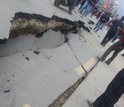Media Advisory 15-017
Will there be another quake in Nepal? Scientists present insights at upcoming conference
Annual Geological Society of America meeting features NSF-supported earthquake research

NSF-funded scientists are working to find new answers to questions about the Nepal earthquake.
October 16, 2015
This material is available primarily for archival purposes. Telephone numbers or other contact information may be out of date; please see current contact information at media contacts.
Will there be another earthquake in Nepal?
Geoscientists funded by the National Science Foundation (NSF) are studying the devastating earthquake of April 25, as well as past Nepal earthquakes, to discover what might happen in the area's seismic future. Between 1833 and 1936, at least five major earthquakes occurred in the region.
The researchers will report their results at a special session of the Geological Society of America's annual meeting in Baltimore, Maryland. (See the meeting's oral session, abstracts and poster session schedule.)
The goals of the special session are to provide a forum for scientists studying the earthquake, and to develop paths forward for earthquake forecasting in the Himalayan region to minimize the effects of large-scale earthquakes.
For example, NSF grantees Rebecca Bendick of the University of Montana and Roger Bilham of the University of Colorado, Boulder--who will present talk 105-6--are measuring post-seismic displacements. Their work involves installing arrays of GPS units along the 21-mile expanse between Nepal's capital, Kathmandu, and the country's southern border to gain new insights into the region's tectonics.
The investigators are placing GPS arrays on stable monuments, with instrument spacing as close as 3 miles.
Bendick and Bilham will use new data to calibrate historical intensity information from Nepal earthquakes in 1833, 1835, 1866, 1934 and 1936. The results will help estimate rupture areas in these events and how they relate to the 2015 earthquake.
| Who: | NSF-supported geoscientists |
| What: | Geological Society of America annual meeting |
| Where: | Convention Center, Baltimore, Maryland |
| When: | Nov. 1-4, 2015; Nepal session: Nov. 2, 2015 |
-NSF-
-
The Nepal earthquake caused numerous damaging landslides throughout the region.
Credit and Larger Version -
Researchers are developing better earthquake forecasting methods through NSF rapid response grants.
Credit and Larger Version -
The Nepal earthquake claimed more than 8,800 human lives and injured nearly 23,000 people.
Credit and Larger Version -
Durbar Square in Kathmandu, before the earthquake.
Credit and Larger Version -
Durbar Square in Kathmandu, after the quake.
Credit and Larger Version
Media Contacts
Cheryl Dybas, NSF, (703) 292-7734, email: cdybas@nsf.gov
Christa Stratton, GSA, (303) 357-1093, email: cstratton@geosociety.org
The U.S. National Science Foundation propels the nation forward by advancing fundamental research in all fields of science and engineering. NSF supports research and people by providing facilities, instruments and funding to support their ingenuity and sustain the U.S. as a global leader in research and innovation. With a fiscal year 2023 budget of $9.5 billion, NSF funds reach all 50 states through grants to nearly 2,000 colleges, universities and institutions. Each year, NSF receives more than 40,000 competitive proposals and makes about 11,000 new awards. Those awards include support for cooperative research with industry, Arctic and Antarctic research and operations, and U.S. participation in international scientific efforts.
Connect with us online
NSF website: nsf.gov
NSF News: nsf.gov/news
For News Media: nsf.gov/news/newsroom
Statistics: nsf.gov/statistics/
Awards database: nsf.gov/awardsearch/
Follow us on social
Twitter: twitter.com/NSF
Facebook: facebook.com/US.NSF
Instagram: instagram.com/nsfgov







